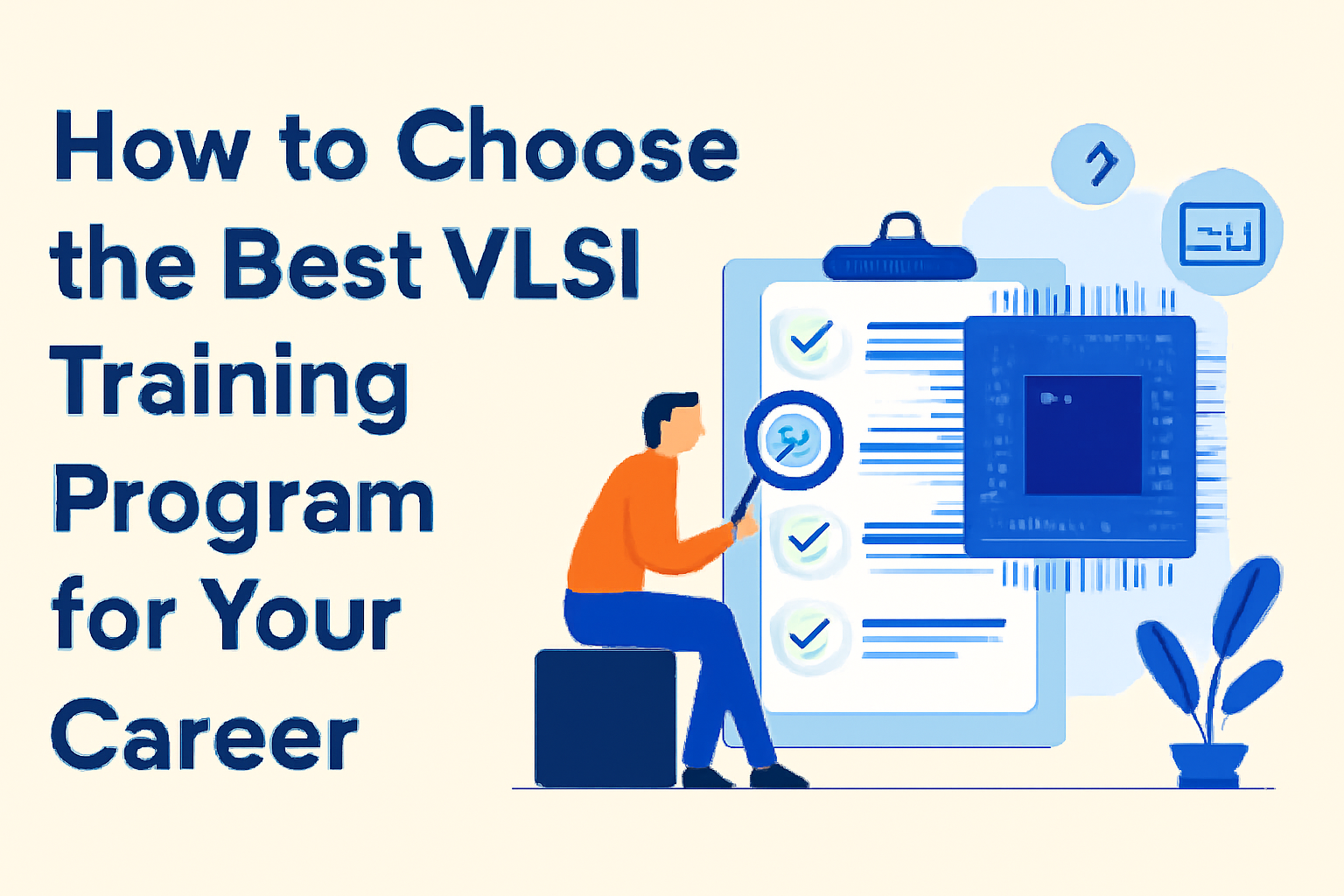How to Choose the Best VLSI Training Program for Your Career
In today’s competitive job market, a career in Very-Large-Scale Integration (VLSI) offers promising opportunities in the semiconductor, electronics, and technology industries. Whether you’re just starting or looking to upgrade your skills, selecting the right VLSI training program is crucial for your career. But how do you choose the best one from the vast array of options available? In this article, we’ll walk you through a simple guide on how to choose the perfect VLSI training program that aligns with your career goals.
1. Understand Your Career Goals
The first step in selecting a VLSI training program is to understand your career goals. VLSI is a vast field, and your training will be more effective if it aligns with your professional aspirations. Are you aiming to become a design engineer? Or do you want to specialize in verification, testing, or physical design? Here’s how you can map out your goals:
- Design Engineer: If you want to create complex integrated circuits, look for a program that offers in-depth knowledge of digital and analog design, as well as tools like Cadence, Synopsys, and Mentor Graphics.
- Verification Engineer: For those looking to ensure that designs are bug-free, courses focusing on languages like SystemVerilog and methodologies like UVM (Universal Verification Methodology) are a great option.
- Physical Design Engineer: This role focuses on the layout and floorplanning of circuits. Training programs that focus on tools like ICC2 and Innovus are essential for this path.
By understanding the area you want to specialize in, you’ll be able to filter out irrelevant programs and focus on those that suit your needs.
2. Research the Training Program’s Curriculum
A good VLSI training program should cover both the theoretical aspects and the hands-on experience required for a successful career in this field. Check the curriculum to ensure it includes:
- Core Topics: Look for a balanced curriculum that covers the essential topics such as digital circuit design, microelectronics, FPGA design, RTL (Register Transfer Level) design, DFT (Design for Testability), verification, and more.
- Tools & Software: VLSI design is heavily tool-based. Make sure the training program offers practical exposure to industry-standard software and tools used for design, simulation, and testing.
- Latest Industry Trends: VLSI technology evolves rapidly. Ensure the program includes modules on cutting-edge topics like low-power design, 5G technology, AI chip design, or emerging semiconductor technologies.
The more comprehensive the curriculum, the better prepared you’ll be for the challenges of a VLSI engineering role.
3. Check for Hands-On Training
Theoretical knowledge alone won’t be enough in VLSI. What makes an excellent training program stand out is the hands-on experience it offers. Look for the following:
- Lab Sessions: These are essential for getting a feel of how VLSI works in the real world. Check if the program provides access to virtual labs or physical labs with industry tools and equipment.
- Project Work: Ensure that the program includes real-world project work. This not only gives you practical experience but also helps build your portfolio, which is crucial when applying for jobs.
- Internship Opportunities: Some VLSI programs partner with companies to offer internships or live project experiences. Internships provide a real-time exposure to the industry and help build your professional network.
Hands-on training will help you better grasp concepts and provide you with the practical knowledge employers value.
4. Look for Experienced Instructors
The quality of instructors can make or break a VLSI training program. Experienced trainers who have worked in the VLSI industry will not only be able to provide up-to-date knowledge but also share insights from real-world experience.
Check the instructors’ profiles to see if they have practical industry experience. Do they have a background in semiconductor companies, or have they contributed to significant VLSI design projects? A program with qualified instructors will give you the edge in the competitive VLSI field.
5. Assess the Program’s Reputation
Before enrolling, research the training program’s reputation. Look for reviews, testimonials, and feedback from past students. Reach out to alumni if possible to get their firsthand experience with the program. Here’s what you should consider:
- Accreditation: Is the training program accredited by recognized authorities in the VLSI or semiconductor industries? Accreditation ensures the program meets certain standards of quality and can increase your employability.
- Industry Recognition: Does the program have a strong relationship with leading tech companies? This could lead to placement assistance, better networking opportunities, and potential job offers.
- Graduate Success: Investigate how successful graduates of the program have been in securing jobs in the VLSI industry. A high placement rate speaks volumes about the quality of the training.
A program with a solid reputation is more likely to provide you with the education and network you need to succeed in your career.
6. Consider Online vs. In-Person Training
With the advent of online learning, you have the option to choose between in-person and online VLSI training programs. Both have their advantages:
- In-Person Training: Offers face-to-face interaction with instructors, peers, and access to physical labs. It also fosters collaboration and networking, which can be valuable for your career.
- Online Training: Provides flexibility in terms of location and timing. You can learn at your own pace, but make sure the online program includes interactive elements like webinars, live sessions, and virtual labs for hands-on experience.
Choose the format that works best with your lifestyle and learning preferences. Both online and in-person options can be effective as long as they offer a comprehensive curriculum and hands-on training.
7. Evaluate the Cost and Duration
Cost and duration are also key factors in your decision-making process. VLSI training programs can vary greatly in terms of price, so you need to evaluate what you’re getting for the cost.
- Cost: Determine if the program offers value for money. Does the cost include access to tools, software, or internships? Does it offer certification or other credentials upon completion?
- Duration: VLSI training can range from a few weeks to several months. If you’re looking to make a quick transition, short-term intensive programs might be a good fit. However, if you prefer a more in-depth study, consider longer programs that provide a more thorough understanding.
Make sure the cost aligns with the quality of the program and fits within your budget.
8. Check Post-Training Support
After completing your VLSI training, you should have access to job placement assistance, career counseling, and ongoing learning resources. Check if the program offers:
- Job Placement Assistance: Many programs offer placement support or have tie-ups with top semiconductor companies.
- Certifications: Look for programs that offer certifications recognized by the industry. Certifications add value to your resume and improve job prospects.
- Continuing Education: VLSI is a rapidly evolving field. Some programs provide continuing education or post-training workshops to keep you updated with the latest trends.
Final Thoughts
Choosing the best VLSI training program for your career can be overwhelming, but by focusing on the factors mentioned above, you can make an informed decision. Whether you’re just starting out or looking to specialize, finding a program that suits your goals, provides hands-on experience, and is taught by industry professionals will set you on the path to a successful career in VLSI. Make sure to do your research, compare programs, and select one that provides the skills, resources, and support you need to thrive in the ever-growing semiconductor industry.


